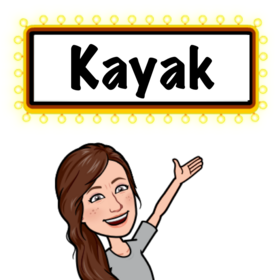Exercises for successful Kayaking!
Lesson Topic:
Arm and Core Strength
Lesson Description:
This lesson instills knowledge of 4 exercises that can build muscular strength and endurance needed for kayaking. Shoulder rotation, Dumbbell curl, Dumbbell twists, & Weighted side bends. After this lesson, the students will be performing these exercises 3 times a week.
Learning Goals/Outcomes:
Students will apply the 6 absolutes of weight lifting to a workout routine for Kayakers.
Students will identify the exercise that can prevent rotator cuff injury.
Students will be able to complete a workout for biceps, core and shoulder strength.
Students will explain how these specific exercises can enhance their enjoyment of kayaking.
Students will be able to evaluate the use of a workout routine in relationship to the increase or decreased enjoyment of kayaking.
Nebraska Standards:
PE.HS.16.2 Applies knowledge of concepts, principles, tactics, and strategies related to movement and performance to achieve and maintain a health-enhancing level of physical activity and fitness.
PE.HS.5.2.b Identifies and uses the major muscle groups in specific exercises.
PE.HS.16.1.a Performs and/or refines activity specific skills in a variety of outdoor pursuits (e.g., kayaking, paddleboarding, fishing, geocaching, orienteering, camping, hiking, mountain biking, climbing, obstacle course, adventure activities, high elements).
PE.HS.16.3.a Applies best practices for participating safely in outdoor pursuits
Teacher Planning:
Equipment/Materials Needed:
- Jump Ropes
- Exercise bands
- Dumbbells - 8 - 20 lbs
- Projector or Video linked in google classroom (optional - teacher can simply lead).
Time Required for Lesson:
20 minutes
Diagram/Setup:
N/A
Technology Use:
_____ YES __x___NO
Instructional Plan:
Anticipatory Set/Pre-Activity:
- Review 6 absolutes for weight lifting.
Athletic Stance - Stand tall - Chest Spread - Eyes on Target - Knees Aligned - Toes Aligned
- Show video of Workout Routine for Kayak.
Benefits/Explanation/Real-World Connection:
Outdoor pursuits such as kayaking require a certain level of fitness. In order to fully participate in the activity and prevent injury, students should know exercises that can help them excel.
Activities (i.e. instructions, warm-up, lesson, cool-down):
Warm Up: Individual Jump rope (5 minutes) *warm up shoulders and arms for strength activity.
Activity: Teacher led instruction on exercises that can improve Kayaking performance, enjoyment and help prevent injuries. Teacher will demonstrate, and highlight correct and incorrect form as well as specific benefits. Students should apply their knowledge of the 6 absolutes to all exercises.
1. Shoulder rotations with Exercise bands, underhand grip. 2x12
Warms up the shoulders for exercise, helps prevent rotator cuff injuries.
2. Dumbbell curls. Curl up, hold one to two seconds, 2x10
Students will alternate curls between right and left arm. Strengthen biceps for forward stroke.
3. Dumbbell Twists: hold with two hands, twist. 1x20
Strengthens core and shoulders, strengthening your torso rotation adds power to your stroke.
4. Weighted side bends. Hold dumbbells above head, crunch straight to side and back. 2x12
Strengthens external obliques, strengthening your torso rotation adds power to your stroke.
Video: Workout Routine for Kayakers
Closure:
Show me the exercise that will benefit you the most? ...... (students demonstrate their answer)
With your elbow partner, talk about why these exercises are important? (Teacher ask various students to share what they heard)
Assessment :
Plickers summative assessment at the end of class:
What exercise can help prevent rotator cuff injury?
A.)Bicep Curls B.)Dumbbell twists C.)Lunges D.) Shoulder Rotations
Supplemental Information:
Modifications:
Students can use variety of dumbbell weights, or just perform the movement if the weight is too much.
Safety Precautions:
Students should choose an appropriate weight, and know proper lifting technique. Students should be spaced so that they do not hit each other. Students should be wearing shoes.
Comments (adaptations for various grades/ages, teaching styles, etc.)
Advanced students could follow the video. Teachers stop after each exercise and allow students to complete the sets and reps.
Students could each be assigned one exercise ahead of time, and groups take turns leading the class in their exercise.
